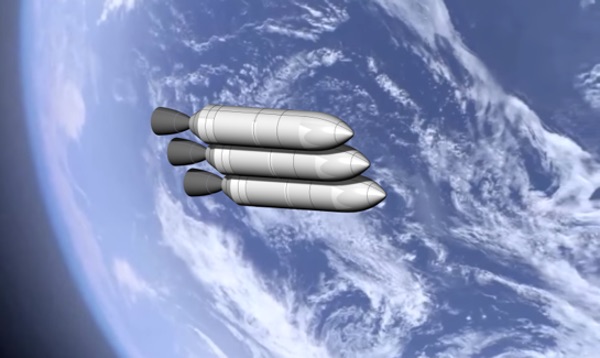Going to the Moon within five years and on the cheap: yes, it is possibleby Dr. Ajay Kothari and Congressman Todd Rokita (ret.)
|
| Four flights of SpaceX Falcon Heavy, costing about $500–600 million, can take 25 tons to the lunar surface and have enough propellant left over for the journey back of the capsule. |
What’s the cause of the paradigm shift in cost? It’s the new availability of reusable rockets costing about five times less, like the whole world witnessed again on April 11 with the successful return of the three Falcon Heavy booster cores. This technology will allow for payloads not before even considered due to their very high costs. It has revolutionized our ability to go to Moon, Mars, and beyond.
Here’s how: The rockets would dock in space, in low Earth orbit, multiple times. To do this there is already a good option that is currently available. Four flights of SpaceX Falcon Heavy, costing about $500–600 million, can take 25 tons to the lunar surface and have enough propellant left over for the journey back of the capsule. Of the four upper stages that would land on the surface, tanks of all but one can be used for future habitats, while one would be used for sending the capsule back to Earth. These tanks left on the surface, after the fuel inside them is expended, are large enough—at 3.5 meters in diameter and 6 to 8 meters in length—for astronauts to live in, walk around, and sleep in comfortably. If inflatable habitats from companies like Bigelow aerospace are placed inside, it would make for a comfortable environment. They could be covered in lunar regolith or placed inside lava tubes to reduce the radiation hazard.
Another alternative could be Blue Origin’s New Glenn, when available. Their technology would make it possible to take even larger payloads such as the Orion capsule with the European Service Module together. New Glenn’s tanks would be palatial in size at 6.5 meters in diameter and 12 meters in length for the empty hydrogen tanks! Multi-use and multi-purpose ideas are necessary to make the Trump/Pence challenge a reality.
If done several times, we actually can have people doing science, learning to live in that environment of one-sixth the gravity of Earth, and also learning to help others live there later by prospecting for water ice. Even this, which would be done over several years, would cost much closer to a few tens of billions of dollars, perhaps, versus the $100 billion estimate quoted elsewhere.
| Multi-use and multi-purpose ideas are necessary to make the Trump/Pence challenge a reality. |
There is an estimated 600 million tons of water ice on the Moon. That is what will fuel our journeys deeper into space. This water ice will not only support life on the Moon, but it can of course also be separated into the propellant mix of liquid hydrogen and liquid oxygen using solar electricity. This amount of water ice is almost a million times more than what we would need to send one rocket from there to other destinations, such as Mars, but far less expensive. When the weaker gravity on the lunar surface compared to Earth is taken into account, this makes the water on the Moon more precious than if diamonds were found there (although we may later find those, too.) When considering the cost of trying to bring this water from Earth, one can easily see its importance. Other countries will go after this resource. We cannot afford to stand idly by, even for a few years.
Yes, President Trump and Vice President Pence are right. It can be done in five years and for a few billion dollars, not a hundred billion as the fear-mongers suggest. The sky will not fall in terms of cost, but the Sun will rise on a better future for the United States and humanity.
Note: we are temporarily moderating all comments subcommitted to deal with a surge in spam.
